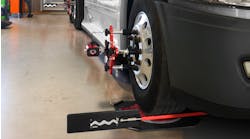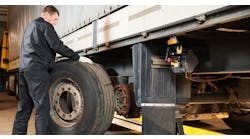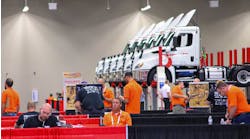Vehicle affected: 2004 Mazda 6 2.3L
Issue – Vehicle pulls to right, steering does not return to center
Tools Used:
· Vehicle Service Information
· Scan Tool
· Four Wheel Alignment Machine
· Power Steering Pressure Gauge Set
· Power Steering Flush Machine
This vehicle was brought in for a seemingly simple repair, a steering pull to the right. As it happens in many cases, the “simple” repair was not as easy as was originally thought. Steering pull issues can usually be resolved by performing traditional maintenance items such as adjusting tire pressures, replacing worn tires, replacing worn steering and suspension components or performing a wheel alignment. In some cases, you will need to go the extra mile to determine, then repair, the cause of the problem.
Step 1 – Determine the history of the issue
This Mazda was referred to the shop for an alignment by another shop that had performed some work on the vehicle to correct the steering issue. After some discussions with the vehicle owner, we found out that this problem had been going on for some time, and the vehicle visited numerous shops which had replaced many parts on the car already.
We were told the struts, tie rods and the right lower control arm had been replaced, all at various times and at different shops. We asked the customer if there was anything that had caused the issue originally, and were told that the car had hit a curb which had initiated the replacement of the control arm. Prior to the impact there had been no steering issues present.
We looked up vehicle information in our Mitchell 1 ProDemand system to make sure there were no TSBs or service campaigns relating to this issue. We also looked up alignment specifications using Mitchell 1 to make sure the specifications were consistent between our alignment machine’s data and the most current service information available.
Step 2 – Duplicate the issue
One of the best practices you can start in your shop is to duplicate the issue the customer has described. This starts with understanding what conditions the vehicle is operating under when the issue occurs. It is also a good idea to have the technician that will be performing the diagnosis drive the vehicle in order to fully understand what is occurring. You should also have the same technician that experienced the problem originally drive the vehicle after the repair, to make sure the issue has been corrected.
When driving the vehicle, the technician noted that the steering effort to the left and right was normal. When returning the wheel back to center from a turn, the left side seemed normal, but the right side required input from the driver to allow it to return. The technician also noted the vehicle had a slight pull to the right at all times.
When you test drive a vehicle with a pulling issue, make sure to accelerate a little in a slight turn to make sure the pull does not get worse. If this occurs in a rear wheel drive vehicle, it can indicate alignment issues or a problem within the differential. If this occurs in a front wheel drive car, it may be caused by a broken motor mount. This car showed no change in steering under acceleration.
It is also necessary with many late model vehicles to make sure there are no traction control or ABS lights on if steering issues are present. Since both Anti-Lock Brake Systems (ABS) and Traction Control Systems (TCS) apply brake pressure to individual wheels, faults in these systems may cause a vehicle to pull to one side or another. In this case, the ABS or TCS indicator lights were not illuminated.
Step 3 – Diagnose the vehicle
Since many potential issues can cause a steering pull, we felt that the normal causes should be ruled out prior to looking any deeper into less common causes.
The tire pressures were tested to make sure they were at the proper specification. The tires were also checked for wear and to make sure they were all the same type and size, since different sizes and tread designs can cause pulling issues. We found no issues with the tires. At this time, we also removed the wheels and calipers to perform a thorough brake inspection. In cases like this we look for uneven brake wear, dragging brakes and signs of overheating.
The next step was to connect a scan tool to determine if there were any fault codes in the ABS or TCS modules. There were no current or pending codes present. A technician performed a quick test drive and observed the scan tool graphing feature for each wheel’s speed. This is done in order to ensure one or more wheels are not reporting different speeds, which can cause the ABS or TCS systems to apply brake pressure to one or more wheel. Since a scan tool graph of the wheel speed sensors is obtained at a relatively low speed, if there was an inconsistency in a wheel, or if you suspect a wheel speed sensor fault, you should recheck the sensors with a lab scope. No issues were detected during the graphing scan.
For the next part of the diagnosis, we performed a repair – a four-wheel alignment. We had already obtained the alignment specifications when we logged into our repair information while checking for TSBs. All of the alignment specifications, including ride height, were correct. In addition, we noticed that some of the adjusting bolts had what appeared to be recent wrench marks on them, most likely indicating an alignment had been done recently.
In the past we have had ball joints that were not showing signs of wear, but were causing tight steering because they lacked lubrication. This is now more common than you would think – mainly due to most vehicle manufacturers making non-serviceable ball joints and other steering components. In order to determine if this was a cause of this issue, and while it would be easy to make any adjustments if required, we disconnected the steering linkage from the control arm and turned the spindles from side-to-side to check for excess resistance. Once again, a relatively common problem was not the cause of this issue.
Based on all of the symptoms, the pull as well as a slight effort to return the steering back to center after a right turn, we suspected the steering rack may have suffered some damage when the vehicle struck the curb. Normally when a steering rack is damaged from an impact, it is difficult to turn in one or both directions, even with the engine off. Since the effort to turn the wheel was normal turning, but required some effort to return in one direction, the steering rack seemed like it may not be the cause.
Just to make sure we did not discount the possibility of the steering rack being the cause, we returned to Mitchell 1 ProDemand to check the specification for power steering pressure. The specification is listed as 1567-1636 PSI.
We connected our Power Steering Pressure Test Set to the vehicle. If you have not used this type of tool before, they are extremely useful to help determine whether a steering pump or the steering gear is causing an issue.
The pressure gauge set comes with adapters that allow the gauge and a bypass control valve to be connected between the pump and the steering gear. Follow these steps to diagnose an issue using this tool:
· Connect the gauge
· Warm the vehicle and recheck fluid level
· Operate the engine at approximately 1500 rpm
· Momentarily close the bypass valve on the gauge and observe the pressure. Be sure you do not keep the valve closed for more than a few seconds in order to prevent damage to the pump.
· The pressure should match the vehicle manufacturer’s specification.
o If the pressure is lower than specified, the pump is faulty
o If the pressure is higher than specified, the pressure relief valve in the pump is faulty
· With the bypass valve open, operate the engine at 1500 RPM while turning the wheel in each direction to the lock position. Observe the gauge pressure.
o The pressure reading at lock should match the pressure reading of the pump when you performed the pump bypass test.
o The pressures turning in each direction should be the same
o If the pressures either do not match the pump bypass test or are not the same side-to-side, the steering gear has an issue and should be replaced.
The tests on the Mazda showed normal on the bypass test (1575 PSI) and showed the same pressure while turning left, but only showed 1400 PSI while turning right.
Step 4 – Repair the vehicle
After the power steering pressure test indicated a problem with the steering rack, this repair was fairly simple: replace the steering rack. In cases of steering rack failure, it is also a good idea to flush the fluid out of the system to make sure there is no contamination from debris. We used our flush machine to clean the system, as well as to assist in bleeding air from the system. Once the rack was replaced, the wheel alignment was reset.
Step 5 – Confirm the repair
Due to this customer’s frustration with this repair, we decided to go one step further in making sure the vehicle was repaired properly. Prior to driving an extended road test, we reconnected the power steering pressure gauge to make sure the pressure readings were consistent with a normally operating system. The gauge readings were the same at both sides and equal to the bypass pressure of the pump. This test, combined with a successful road test, assured us we had performed a complete repair and had taken care of a frustrating issue for the customer and a couple of other shops as well.



